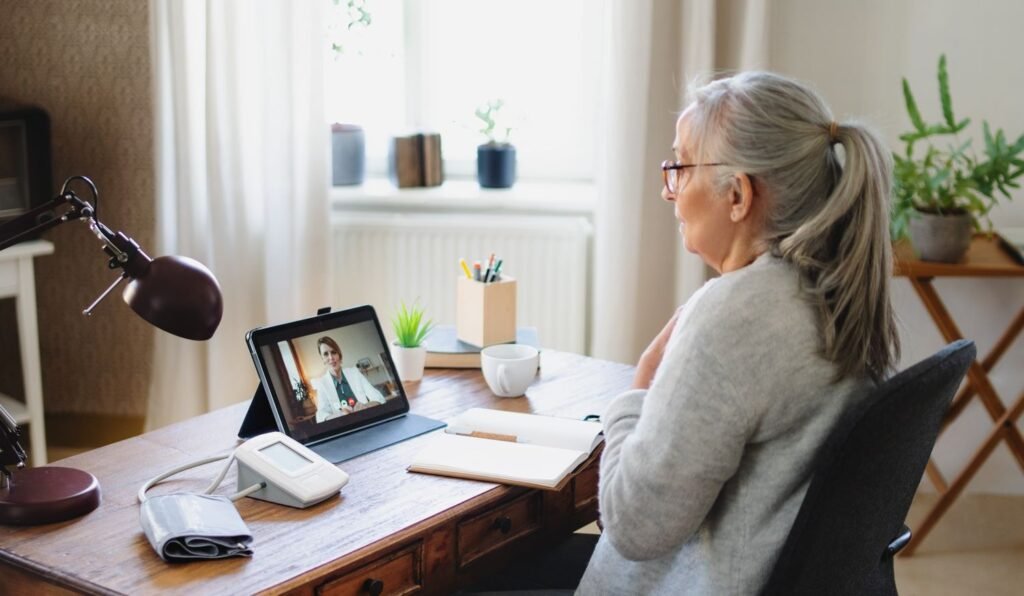:max_bytes(150000):strip_icc():format(jpeg)/GettyImages-1317435850-2eb3559fabbe417091d4ecbf84ddce2e.jpg)
Retirement life is different from what it was generations ago. Thanks to accessible and easy-to-manage technology, retirees are using phones, watches, and other devices to stay healthier, safer, and connected to their loved ones.
“AI, ChatGPT and other tools are as significant a change as the introduction of the internet,” says Laurie Orlov, founder of Aging and Health Technology Watch. “They are enabling older adults, but more importantly, their health providers to obtain information and insights in a conversational way that was not possible, and not ad-free, previously.”
Below, we discuss how technology is changing retirement.
Key Takeaways
- Retirees are embracing user-friendly technology, like smart speakers, wearable devices, and video calls, to stay safe, independent, and connected.
- Tools like telehealth visits, motion sensors, and senior-focused financial apps are making it easier for older adults to manage their health and finances from home.
- From virtual fitness classes to online book clubs, retirees are using technology to stay social, active, and engaged in ways that weren’t possible before.
Everyday Tech’s Impact
Technology today isn’t just geared towards the younger generation, and there are many devices created specifically with older users in mind. What was once complicated is now easy to understand, affordable, and sometimes even fun.
The options available to retirees range widely, from motion sensor lights that prevent falls to watches that track heart rhythms, providing them with the opportunity for safer and healthier living.
For example, imagine how technology might affect a retiree living in a small town by herself. With some help from relatives or neighbors, a smart speaker and motion sensors can help keep her safe and connected to her loved ones.
After a while, what begins as a convenient way to turn on lights and music might also become a lifeline: reminders to take medication, alerts if she hasn’t moved for a while, and an easy way to call for help.
More retirees are using wearable health monitors like Apple Watch or Fitbit to track their sleep, steps, and irregular heart rhythms, providing insights and catching problems early before they become serious.
“Self-service capabilities for managing healthcare, including scheduling appointments, getting test results, and interacting with physicians via telehealth, all have had a major impact,” Orlov says.
During the pandemic, telehealth was a necessity for many, and it has remained popular since. Retirees who can’t drive, live in remote areas, or have limited mobility can speak to doctors directly from their homes, making check-ins more frequent and easier while avoiding unnecessary trips.
Design Simplicity and Senior Needs
Improved usability has become a boon for retirees, with developers designing apps and software for all ages and levels of technical ability.
“Developers and tech companies need to test technologies with older adults, and sponsor training that expands access to technologies,” says Orlov.
“AARP, the Consumer Technology Association and its CTA Foundation, and Best Buy Health are all examples of organizations trying to improve accessibility and user-friendliness for older adults. Also, IEEE has launched a global standards initiative for older adults tech that is attempting to upgrade the usability,” she says.
Financial apps like EverSafe or SilverBills are built specifically for older adults. A SilverBills membership costs $200 a month, with additional costs depending on usage. These apps help pay bills, flag suspicious activity, and even provide designated family members with the ability to monitor accounts without the loss of privacy.
In addition to the financial needs of retirees, there are also plenty of health apps, from daily stretch routines to wellness to health logs that sync with your doctor’s portal to make managing your own health a way to remain independent in your retirement years.
Fast Fact
According to the U.S. Census Bureau, by 2034, older adults will outnumber children for the first time in U.S. history.
Connection
Technology is also helping people stay in touch, from texts to video calls to anyone in the world. Retired people no longer need to feel isolated if they live alone.
“Technology can be a major factor in reducing isolation among older adults. Generally available tech like FaceTime, text messaging, group chats, and social media can play useful roles,” says Orlov. “Captioned telephones can reduce social isolation for people who are deaf or severely hearing-impaired.”
In addition to video calls, there are group fitness classes on YouTube, digital book clubs, and even dating apps for the elderly, all allowing for a vibrant life in non-working years. The internet has forever altered how people spend their retirement.
The Bottom Line
Technology has transformed retirement into a time of greater independence, engagement, and safety. With easily accessible and intuitive devices, older adults can manage their health, finances, and social lives easily.
From smart sensors and wearable devices to telehealth and digital spaces, technology allows retirees to lead fuller, healthier, and more connected lives.

